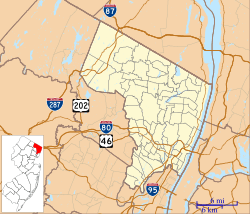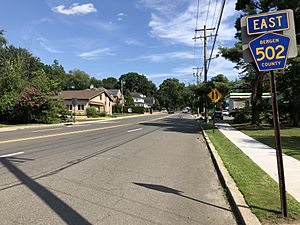Closter, New Jersey facts for kids
Quick facts for kids
Closter, New Jersey
|
||
|---|---|---|
|
Borough
|
||
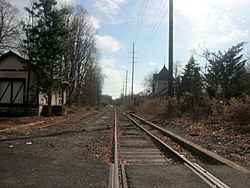
The former station depot of the Erie Railroad's Northern Branch as seen from the crossing of County Route 502 (High Street) in Closter
|
||
|
||
| Nickname(s):
"Hub of the Northern Valley"
|
||
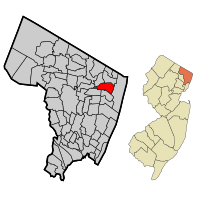
Location of Closter in Bergen County highlighted in red (left). Inset map: Location of Bergen County in New Jersey highlighted in orange (right).
|
||
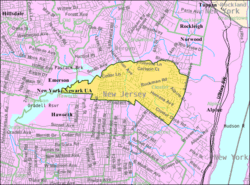
Census Bureau map of Closter, New Jersey
|
||
| Country | ||
| State | ||
| County | Bergen | |
| Incorporated | January 1, 1904 | |
| Government | ||
| • Type | Borough | |
| • Body | Borough Council | |
| Area | ||
| • Total | 3.30 sq mi (8.55 km2) | |
| • Land | 3.16 sq mi (8.18 km2) | |
| • Water | 0.14 sq mi (0.37 km2) 4.30% | |
| Area rank | 325th of 565 in state 24th of 70 in county |
|
| Elevation | 39 ft (12 m) | |
| Population
(2020)
|
||
| • Total | 8,594 | |
| • Estimate
(2023)
|
8,544 | |
| • Rank | 278th of 565 in state 47th of 70 in county |
|
| • Density | 2,719.6/sq mi (1,050.0/km2) | |
| • Density rank | 236th of 565 in state 45th of 70 in county |
|
| Time zone | UTC−05:00 (Eastern (EST)) | |
| • Summer (DST) | UTC−04:00 (Eastern (EDT)) | |
| ZIP Code |
07624
|
|
| Area code(s) | 201 exchanges: 750, 767, 768, 784 | |
| FIPS code | 3400313810 | |
| GNIS feature ID | 0885190 | |
Closter (/ˈkloʊstər/) is a lovely borough located in Bergen County, New Jersey. It's a great place to live, with a population of 8,594 people as of the 2020 census. Closter is known for its friendly community and beautiful surroundings.
Contents
- Closter's Past: A Look at Its History
- Where is Closter? Its Geography
- Who Lives in Closter? Demographics
- Closter's Economy and Shopping
- Sports and Recreation in Closter
- Parks and Green Spaces
- Education in Closter
- Places of Worship
- Getting Around Closter: Transportation
- Famous People from Closter
- See also
Closter's Past: A Look at Its History
The land where Closter now stands was first home to the Lenape Native Americans. They farmed, hunted, and fished here for many years.
Dutch Settlers and the Name "Closter"
In the early 1700s, Dutch settlers arrived and made a lasting impact. The first official land deed for this area was written on April 13, 1671. Later, in 1710, Barent and Resolvert Nagel, along with the Vervalen family, were among the first to settle what is now Closter.
The name "Closter" comes from the Dutch word Klooster, which means "a quiet place" or "a monastery." It was first pronounced "Klowster." Over time, as English culture became more common, the spelling and pronunciation changed. By 1795, it became "Closter," with the "long o" sound we use today.
Why Closter Was Unique
Closter's location, tucked behind the high Palisades cliffs, gave it a sense of being a protected, isolated place. You can still see reminders of Closter's Dutch past today. Many local streets are named after early Dutch families, like Bogert, Demarest, and Haring. You can also find unique "Jersey Dutch" style houses.
The Arrival of Trains and Growth
In 1859, the Northern Branch railroad arrived, followed by other train services. This made it easier for people to travel to Manhattan by taking a ferry across the Hudson River. Because of its central location, Closter earned the nickname "Hub of the Northern Valley."
Closter officially became a borough on January 1, 1904. After 1900, Closter changed from a place of large farms to a thriving suburban town.
Where is Closter? Its Geography
Closter covers about 3.30 square miles (8.55 square kilometers). Most of this area is land, with a small part being water.
Climate and Nearby Towns
Closter has a humid subtropical climate, which means it has warm, humid summers and mild winters.
Closter shares its borders with several other towns in Bergen County. These include Alpine, Demarest, Emerson, Harrington Park, Haworth, and Norwood.
Who Lives in Closter? Demographics
| Historical population | |||
|---|---|---|---|
| Census | Pop. | %± | |
| 1890 | 513 | — | |
| 1900 | 1,057 | 106.0% | |
| 1910 | 1,483 | 40.3% | |
| 1920 | 1,840 | 24.1% | |
| 1930 | 2,502 | 36.0% | |
| 1940 | 2,603 | 4.0% | |
| 1950 | 3,376 | 29.7% | |
| 1960 | 7,767 | 130.1% | |
| 1970 | 8,604 | 10.8% | |
| 1980 | 8,164 | −5.1% | |
| 1990 | 8,094 | −0.9% | |
| 2000 | 8,383 | 3.6% | |
| 2010 | 8,373 | −0.1% | |
| 2020 | 8,594 | 2.6% | |
| 2023 (est.) | 8,544 | 2.0% | |
| Population sources: 1910–1920 1910 1910–1930 1900–2020 2000 2010 2020 |
|||
As of the 2010 census, Closter had 8,373 people living in 2,747 households. The population density was about 2,646 people per square mile.
Population Makeup
Most residents (about 64%) were White, and about 31% were Asian. Around 6% of the population identified as Hispanic or Latino. Korean Americans made up a significant part of the population, at 21.2%.
The average household size was 3.02 people. About 43.4% of households had children under 18. The median age in Closter was 43.2 years.
Closter's Economy and Shopping
Closter has a popular outdoor shopping center called Closter Plaza. It features stores, restaurants, and a movie theater.
Closter Plaza's Renovation
Originally built in the 1960s, Closter Plaza underwent a big renovation starting in 2015. This project added new stores like Whole Foods, Target, and HomeGoods. The renovated mall, which covers 16 acres, was completed in late 2016.
Interestingly, in 2012, parts of the movie The Wolf of Wall Street were filmed at the mall!
Sports and Recreation in Closter
Closter offers fun activities for sports lovers.
Closter Golf Center
The Closter Golf Center has a large, two-story driving range with 120 stalls. It also has a mini golf course, perfect for a fun outing with friends or family.
Parks and Green Spaces
Closter has several parks where you can play, relax, and enjoy the outdoors:
- Amendola Park – Located on Willow Road, this park has a playground for kids.
- High Street Park – Found at the corner of High Street and Piermont Road, it offers a playground and a fitness area.
- Memorial Field – Also known as Veterans Memorial Field, it's on Harrington Avenue. This park features a playground, athletic fields, and a bandshell. It also has memorials for U.S. Veterans and those who died on September 11.
- Mollicone Park – This baseball field is at the intersection of Knickerbocker Road and Eckerson Avenue. It's named after Donald Mollicone, a Closter native and Vietnam War veteran.
- Ruckman Park – Located at Piermont and Ruckman roads, this park has athletic fields, a walking/jogging path, and a playground.
- Schauble Park – On Bergenline Avenue, this park offers a playground, a bike path, and athletic fields.
Education in Closter
Closter has excellent schools for students of all ages.
Closter Public Schools
The Closter Public Schools serve students from pre-kindergarten through eighth grade. The district has two schools:
- Hillside Elementary School – For students in PreK through 4th grade. In 2021, Hillside Elementary was recognized with the prestigious Blue Ribbon School Award of Excellence.
- Tenakill Middle School – For students in 5th through 8th grade.
High School Education
Students in ninth through twelfth grades attend Northern Valley Regional High School at Demarest in Demarest. Students from Demarest and Haworth also attend this high school. This school is part of the Northern Valley Regional High School District, which serves several nearby towns. Northern Valley Regional High School at Demarest also received the Blue Ribbon School Award of Excellence in the 1994–1996 school years.
Before this high school opened in 1955, local students attended Closter High School.
Specialized Programs
Students in Bergen County, including Closter, can also apply to special secondary education programs. These are offered by the Bergen County Technical Schools, which include the Bergen County Academies in Hackensack and the Bergen Tech campuses in Teterboro or Paramus. These programs offer unique learning opportunities for students interested in technical fields.
Places of Worship
Closter is home to different places of worship:
- The Church of Saint Mary is a Roman Catholic church that holds daily and weekend masses. It also offers religious education for young people and adult programs. The church is known for its 33 beautiful stained glass windows.
- Temple Emanu-El is a Conservative synagogue. It holds weekly services and has a Hebrew school for children starting at age 3.
Getting Around Closter: Transportation
Closter has a good network of roads and highways.
Roads and Highways
Several important county roads pass through Closter, including County Route 501, County Route 502, and County Route 505.
You can also reach Closter using the Palisades Interstate Parkway and U.S. Route 9W, which are in neighboring towns.
Public Transportation
If you need to travel to Midtown Manhattan, you can take NJ Transit bus routes 167 and 177. These buses travel along Schraalenburgh Road to the Port Authority Bus Terminal.
Coach USA's Rockland Coaches also provides bus service from Closter to the Port Authority Bus Terminal via the 20 bus route.
Famous People from Closter
Many interesting people have lived in or are connected to Closter:
- Coe Finch Austin (1831–1880), a botanist.
- Abram Belskie (1907–1988), a sculptor.
- Emme (born 1963), a famous plus-size model.
- Bill Evans (1929–1980), a well-known jazz pianist and composer.
- Brian Gorman (born 1959), a Major League Baseball umpire.
- Tom Gorman (1919–1986), also a Major League Baseball umpire.
- Bruce Harper (born 1955), a former NFL running back for the New York Jets.
- Richard Hunt (1951–1992), a puppeteer famous for his work with The Muppets.
- Helen Jepson (1904–1997), a lyric soprano who sang at the Metropolitan Opera.
- Marcel Jovine (1921–2003), a sculptor who created "The Visible Man" and "The Closter Seal."
- Tommy La Stella (born 1989), a professional baseball player.
- Robert Lipsyte (born 1938), a sports journalist and author.
- Sam Lipsyte (born 1968), an author.
- Rich Luzzi (born 1978), the frontman for the band Rev Theory.
- Regan Mizrahi (born 2000), an actor known as the voice of Boots the Monkey on Dora the Explorer.
- Mike Stanton (born 1967), a former MLB relief pitcher for the New York Yankees.
See also
 In Spanish: Closter para niños
In Spanish: Closter para niños



